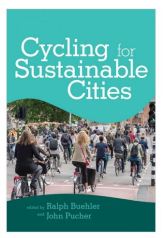Link to Book Website

Cycling for Sustainable Cities
How to make city cycling—the most sustainable means of travel—safe, practical, and convenient for all.
Cycling is the most sustainable means of urban travel, practical for most short- and medium-distance trips—commuting to and from work and school, shopping, visiting friends—as well as for recreation and exercise. Cycling promotes physical, social, and mental health, helps reduce car use, enhances mobility and independence, and is economical for both public and personal budgets. Cycling should be made feasible for everyone and not limited to especially fit, daring, well-trained cyclists riding expensive bicycles. Cycling for Sustainable Cities shows how to make city cycling safe, practical, and convenient for all ages and abilities.
After discussing the latest cycling trends and policies around the world, contributors consider specific aspects of cycling. They examine such topics as health benefits; cycling facilities, including traffic-protected bike lanes; cycling incentives; the needs and preferences of women, children, and older adults; and equity and social justice. Expanding on the earlier book, City Cycling, they explore cycling developments in Asia and Latin America and analyze cycling evolution and innovations in New York, London, Paris, Amsterdam, Copenhagen, Portland (Oregon), and Sevilla. Taken together, the chapters show that successful promotion of cycling depends on a coordinated package of mutually supportive infrastructure, programs, and policies.
Previous Book
 City Cycling
City Cycling
Bicycling in cities is booming, for many reasons: health and environmental benefits, time and cost savings, more and better bike lanes and paths, innovative bike sharing programs, and the sheer fun of riding. City Cycling offers a guide to this urban cycling renaissance, with the goal of promoting cycling as sustainable urban transportation available to everyone. It reports on cycling trends and policies in cities in North America, Europe, and Australia, and offers information on such topics as cycling safety, cycling infrastructure provisions including bikeways and bike parking, the wide range of bike designs and bike equipment, integration of cycling with public transportation, and promoting cycling for women and children.
City Cycling emphasizes that bicycling should not be limited to those who are highly trained, extremely fit, and daring enough to battle traffic on busy roads. The chapters describe ways to make city cycling feasible, convenient, and safe for commutes to work and school, shopping trips, visits, and other daily transportation needs. The book also offers detailed examinations and illustrations of cycling conditions in different urban environments: small cities (including Davis, California, and Delft, the Netherlands), large cities (including Sydney, Chicago, Toronto and Berlin), and “megacities” (London, New York, Paris, and Tokyo). These chapters offer a closer look at how cities both with and without historical cycling cultures have developed cycling programs over time. The book makes clear that successful promotion of city cycling depends on coordinating infrastructure, programs, and government policies.
MIT Press. Urban and Industrial Environments series.
ISBN-10: 0-262-51781-7
ISBN-13: 978-0-262-51781-2

You must be logged in to post a comment.